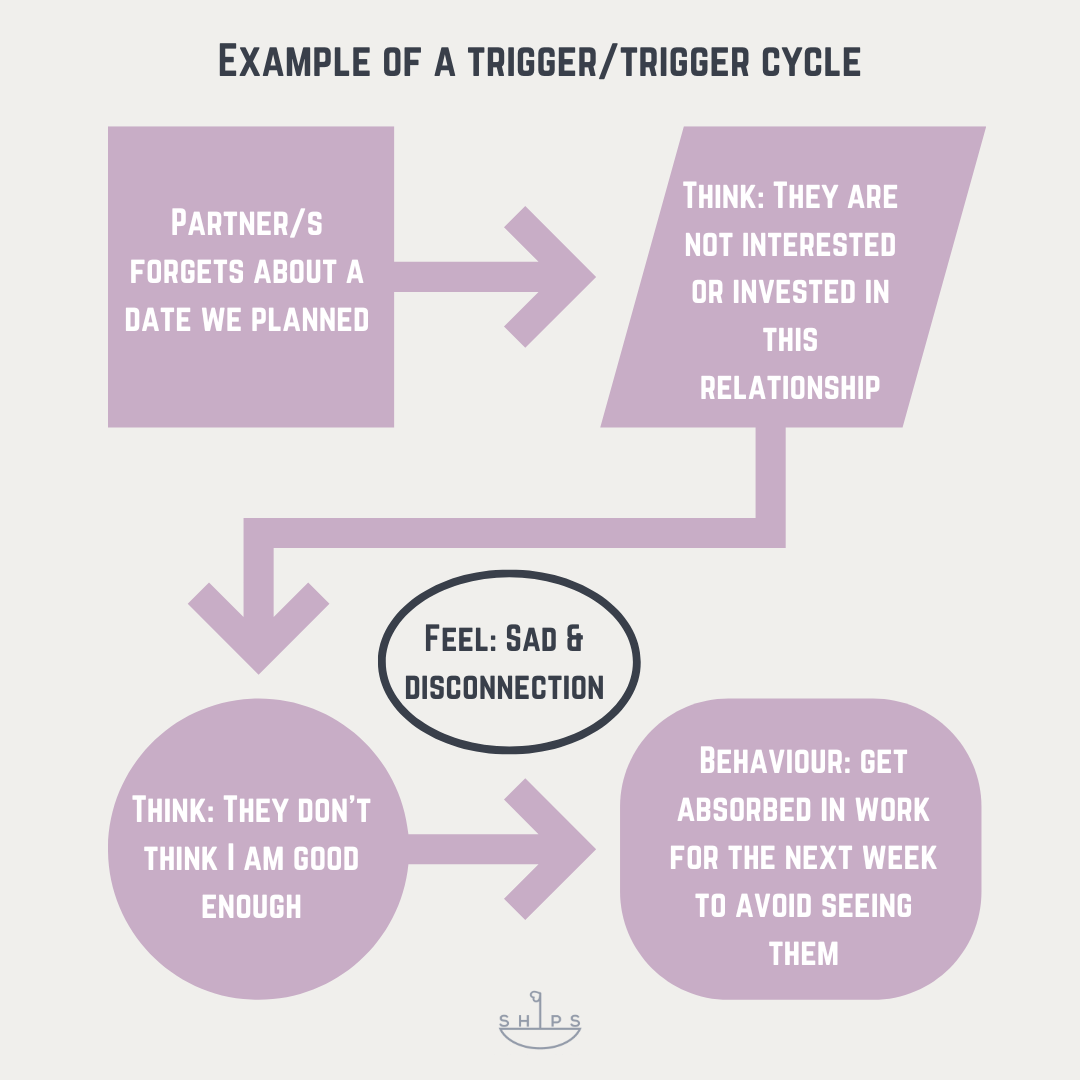Avoidant attachment: What can healing in a relationship look like for you?
Our attachment style describes the way we have learnt to meet out needs in relation to others. We learn this during our early experiences with a caregiver and this forms the blueprint for how we function in in adult relationships.
Avoidant attachment involves denying and suppressing needs internally and externally. People who are avoidantly attached often don’t really believe that their needs are important or can be met so we can focus on independence and achievement instead. They might not have learnt how to recognise how they feel or what they need, so this can make communicating this in a relationship difficult.
Understand your triggers & cycle
If you are avoidantly attached, there will be particular internal or external triggers that will provoke a cycle of thoughts, feelings and behaviour.
Eg. Partner forgets about a date we planned -> Think: They are not interested or invested in this relationship -> Think: They don’t think I am good enough -> Feel: Sad & disconnected -> Behaviour: get absorbed in work for the next week to avoid seeing them.
Notice what it feels like when you are triggered
To build new patterns, it is first necessary to notice when the old ones are repeating themselves.
When you are avoidantly attached it can be difficult to learn to notice emotional responses in your body (because you learnt to avoid them) so it can be easier, sometimes to notice behaviours that are connected to being triggered.
Eg. Lot’s of time immersed in video games, not engaging in daily self-care tasks, drinking more than usual
When you notice these behaviours, see if you can identify how you are feeling in your body Eg. foggy head, heaviness in the body and what might trigger these feelings.
Understanding where they come from
If you have an avoidant attachment style as an adult, then it is useful to identify the experiences that led to this as a child eg. lack of attunement from a caregiver, lack of physical presence and involvement
Recognising where the attachment style helps you to link the trigger & the cycle to the real sources.
Your partner’s behaviour might have triggered the cycle, but the cycle and all the thoughts, feelings and behaviour that is connected to it, is an adaptation from your early experiences. The fear is connected to the past, not to the current circumstances.
Learning to connect to emotions & self-soothe
Building new patterns involve connecting with emotions (rather than avoiding them, numbing out) and responding to them with care.
Ways that you can connect with emotions.
Write in a journal for 5 minutes each morning
Meditate and notice what arises
Practice yoga to notice what shows up in your body
Engage in a creative activity eg. drawing
Ways that you can self soothe:
Repeat soothing affirmations - ‘You are loved’, ‘I am here’
Listen to some relaxing music you like
Pat an animal
Watch a video clip that makes you laugh
Build a new relationship blueprint
Once you are able to recognise the old cycle and ground yourself, it is time to start replacing this with a new blueprint for a healthy relationship. This includes thoughts, feelings and behaviours that help you to have secure attachments
Examples:
Notice: My partner expresses love to me in many different ways
Feeling: Notice the times that your feel connected and safe with your partner
Behaviour: Share how you are feeling about your partner’s behaviour, let them know what makes you feel noticed and loved
Image made by Mikaela - Event & Communication Assistant
This blog post is a brief exploration of this topic and does not replace therapy. At SHIPS, we have practitioners that are knowledgeable and skilled in a variety of areas including sex therapy, relationships and more. If you may benefit from some support, please check out our website resources, or contact us.
We are also always happy to hear feedback about our blog articles. If you would like to share your experience or feel we may have missed something on this topic, please contact us to let us know.
How can SHIPS support you?
AUTHOR
Dr. Sarah Ashton, PhD
Director & Founder of Sexual Health and Intimacy Psychological Services (SHIPS)








